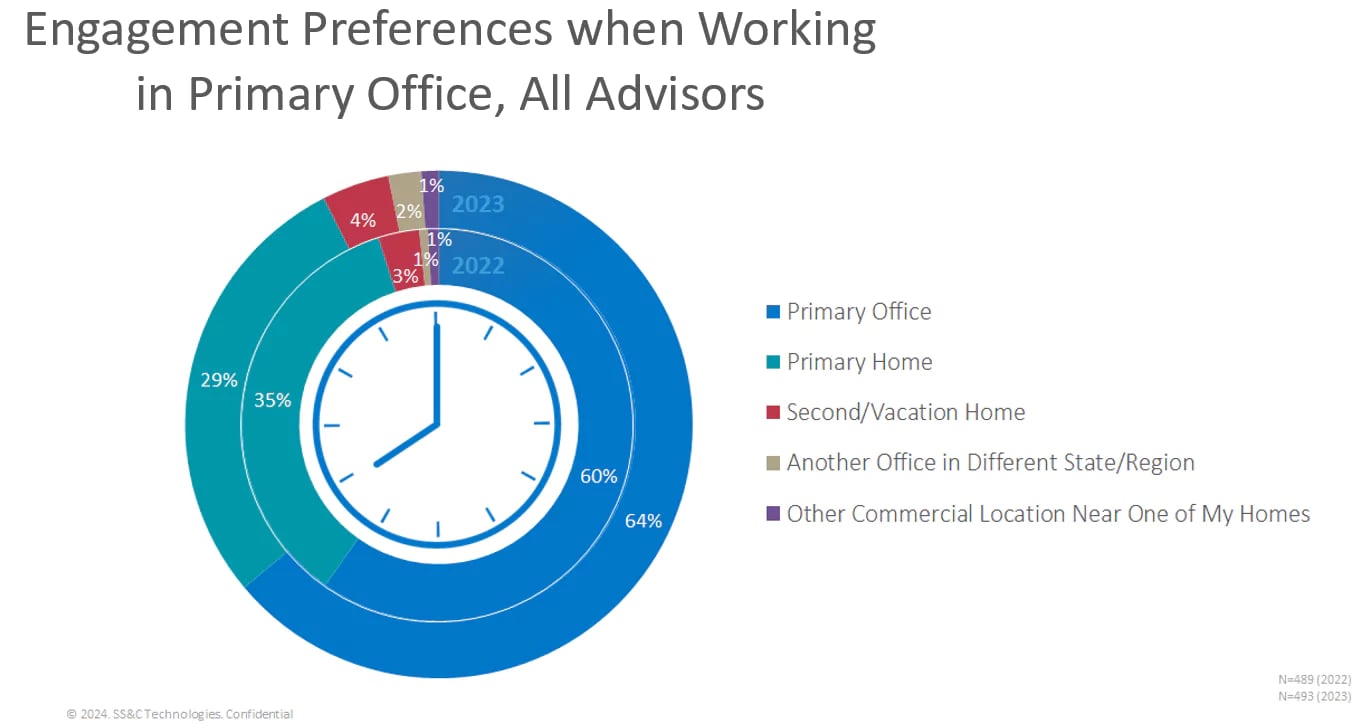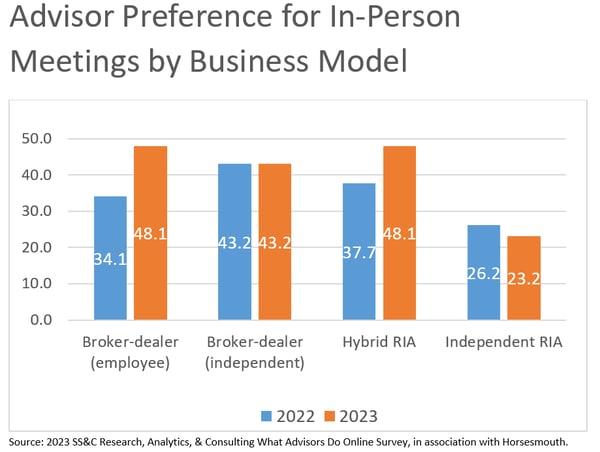BLOG. 4 min read
Three Ways to Win Meetings with Zoomed-Out Advisors
April 16, 2024 by Jackie Noblett
Four years after the vast majority of the financial services world was relegated to Zoom meetings and digital correspondence, a large number of advisors want to get back to shaking hands with salespeople.
Financial intermediaries reported in 2023 spending two-thirds of their work time in an office, according to SS&C’s 2023 “What Advisors Do Online” survey, conducted in association with Horsesmouth. When they are there, 44% of advisors say that their preference for engaging with wholesalers is via an in-person meeting. That is up 13 percentage points from 2022, when 31% of advisors preferred in-person meetings when they are working in the main office. Demand for virtual meetings and phone meetings had slight declines between 2022 and 2023.

This is music to the ears of asset manager sales executives, who have spent the past couple of years prodding their wholesalers to get back into branch offices and RIA headquarters to get face time with clients and prospects versus FaceTime-like virtual meetings. Firms are including activity metrics into their KPIs and compensation plans, encouraging salespeople to meet with their top clients several times a year.
But advisor preference for being in the same room only means as much as their desire to meet with your firm’s representative, which is hardly a given—especially if you are trying to break in with an intermediary. So how does a wholesaler increase their chances of having an advisor sit down with them during their in-office time? Here are three suggestions:
- Use data to identify advisors most likely to take a meeting.
The significant rise overall in advisors’ preference for in-person meetings obscures some significant variation in interest among various advisor business models. For example, a significantly higher share of employees of broker-dealers and hybrid RIAs prefer in-person meetings when in the office than independent RIAs. Not surprisingly, independent RIAs planned to spend the least amount of their work time in the office (54.6%), as compared to 74.1% of broker-dealer employees’ time.
These differences highlight the importance of wholesalers understanding the engagement preferences of their most important clients and prospects, and matching the service level accordingly. Sales enablement teams can help present that information by mining activity data in CRM systems, sales transaction history, marketing analytics and other methods to come up with a list of advisors for whom an in-person meeting can provide real value. They can also serve up data to help wholesalers maximize their time in the office, and increase the likelihood the advisor will meet with them again.
- Get other advisors to speak highly of you to their colleagues.
In an age of TV talking heads and social media influencers, advisor advocacy continues to be an incredibly powerful business development tool. More than half (52.6%) of the 1,200 advisors that we surveyed last year as part of our “Advisor Insights” survey series with Horsesmouth said that a colleague’s recommendation was one of the most likely ways to be persuaded into meeting with a salesperson with whom you do not currently do business. About a quarter (25.3%) said they would be persuaded by a recommendation from their firm’s senior management.
It is clear evidence that, with all of the data at advisors’ fingertips to research and evaluate products, human relationships built on trust still very much matter. Building that level of trust takes intense effort—and time—but wholesalers can strategically leverage the strong relationships they have to get in front of advisors their firms have identified as high-opportunity targets. It could be a joint meeting with that advisor and their colleagues on a topic mutually beneficial; it could be an email introduction.
Trust is also critical to existing clients, for whom getting regular face-to-face contact remains a challenge. Advisors met with just under seven firms last year, on average, our “Advisor Insights” survey data shows. But only four of those firms did they meet with more than once.
Wholesalers can increase their advocacy scores, however, by doing their homework on clients’ practices and tailoring their engagements to meet specific needs. - Provide content and information that is relevant to their practice, and not just product pushes.
Our “What Advisors Do Online” survey highlights the link between content and building trust. Over three-quarters of respondents said providing timely insights to help clients understand major market events were important or very important to building trust and confidence with a firm. Seven in 10 respondents said consistently valuable insights from marketing, economic or investment experts were important or very important to trust building.
The challenge may be that wholesalers aren’t effectively tapping into that demand for information in their in-person meetings. Advisors in the “Advisor Insights” survey said, on average, that just 38.7% of wholesaler meetings provided some value. That’s far too low to incentivize advisors to take another meeting when they could be spending time with clients or performing other tasks.
The first step is coming to the table with an understanding of that advisor, their practice and the way they think about wealth management. It’s not just about what products they use and in what wrapper; it’s understanding their pain points and those of their clients, and being creative in how you help them alleviate the pressures. External wholesalers cannot do this alone. Internals can serve a critical role in becoming “territory experts” and arming externals with the right content to maximize the relationship-building value of those engagements.
Nothing develops trust and confidence like looking a person in the eye and reading their body language. With more advisors desiring such engagements now than at any time since the pandemic, asset managers have a prime opportunity to deepen their most important relationships.
But wholesalers need to come into in-person meetings thinking about more than just the products or services they are eager to sell. Relationship building is about meeting the client where they are and providing relevant support in their practice journey, and that’s how you maintain a firm grip on opportunities to shake hands with your most valuable advisors.
To learn more about advisors’ needs and behaviors, learn more about SS&C’s Distribution Solutions.
Written by Jackie Noblett
Senior Research Analyst






